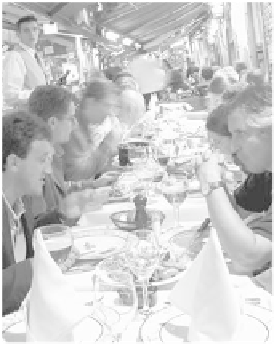Travel Reference
In-Depth Information
EATING
For many, the obvious eating tip in Brussels is simply to enjoy the
Grand Place. My vote for northern Europe's grandest medieval
square is lined with hardworking eateries that serve the predictable
dishes to tourist crowds. Of course, you won't get the best quality
or prices—but, after all, it's the Grand Place. Locals advise eating
well elsewhere and enjoying a Grand Place perch for dessert or a
drink. While many tourists congregate at the Rue des Bouchers,
“Restaurant Row,” consider a wander through the new emerging
eating zone—gay, ethnic, and trendy—past the Bourse near Place
Saint-Géry. Compare the ambience, check posted menus, and
choose your favorite.
Brussels is known for both its high-quality, French-style
cuisine and for multicultural variety. Seafood—fish, eel, shrimp,
and oysters—is especially well-prepared here. As in France, if
you ask for the
menu
(muh-noo) at a restaurant
,
you won't get a
list of dishes; you'll get a fixed-price meal.
Menus
, which include
three or four courses, are generally a good value if you're hungry.
Ask for
la carte
(lah kart) if you want to see a printed menu and
order à la carte, like the locals do. For more on Belgian cuisine,
see page 366.
Mussels in Brussels
Mussels
(moules)
are available all over town. For an atmospheric
cellar or a table right on the Grand Place, eat at
't Kelderke.
Its
one steamy vault under the square is always packed with both
natives and tourists—a real Brussels fixture. It serves local special-
ties, including mussels (a splittable kilo bucket—just more than 2
pounds—for €20-22; daily 12:00-24:00, Thu-Sat until 2:00 in the
morning, no reservations, Grand Place 15, tel. 02-513-7344). Also
see
Restaurant Chez Leon, next page.


















